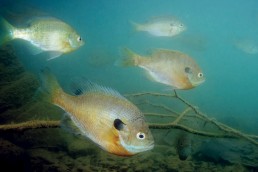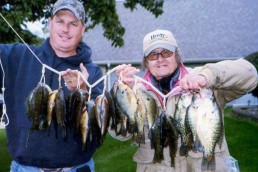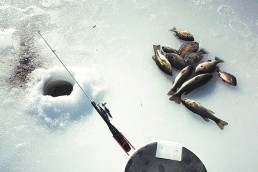Steal my System for Catching Big Bluegills all Day
SHARE THIS POST
There was just enough light to see when we made our way down the game path that led to the edge of the one-acre farm pond. We followed the deer trail to the muddy end of a point that tapered into the water. Behind us the corn leaves rustled whispering secrets that drifted away on a light south breeze. On the water, at the edge of the moss-line and beyond, a hundred little circles that looked like dimples on golf balls, appeared and disappeared. I knew these to be bluegills feeding on the surface and felt the familiar lightning bolt of anticipation.
My good buddy, Buck, who is a biologist by trade, once explained to me why the ‘gills act that way. The brightening sunlight causes phytoplanktons, which are microscopic bits of algae that rise to the water’s surface. Zooplankton, microbes smaller than the head of a pin and with exotic names such as roiters, boatmen, and copepods, rush to the water’s surface to feed on the bits of algae. Water insects, tiny minnows, baby crawdads and a dozen more organisms leave their refuge in the moss to dine on the zooplankton. This rings a dinner bell to the bluegills that come and feed on those diners like they are popcorn. This feast lasts until direct sunlight drives the ‘gills into deeper water.
This early morning time is magic for the fly rod enthusiasts. An angler using a fly rod, with a dry fly such as a 9-foot, 4-weight fly rod with a floating line and 2-weight leader, topped with a dry fly such as a black spider or black gnat can have a blast. A delicate presentation is required because big ‘gills spook easily. Just cast into the middle of the dimples and wait. When your nerves threaten to blow, twitch your lure a little. See what happens.
This morning I was using my lightweight 7-foot spinning rod and open faced spinning reel (a 300 Mitchell I bought in 1964), which was strung with 4-pound-test mono and rigged with a 1/64-ounce Little Nipper black jig from Lindy. I baited the jig with a yellow meal worm and made a longish cast that landed my lure at the edge of the moss-line. Immediately I had a hit. The ‘gill splashed the water’s surface, curveted, and made several slashing runs towards the moss. I headed the fish off and landed it. Measured against the length of my hand, I judged the colorful male to be four inches—not a keeper. I told him good-luck and slipped him back into the water.
“You’ll always catch the big ones out 6 to 8 feet from that hydrilla bed,” my fishing buddy, Buck, said from his spot on the bank.
“I know it—a bad cast,” I answered.
Are you enjoying this post?
You can be among the first to get the latest info on where to go, what to use and how to use it!
My next cast was farther away from the moss and my jig felt like it had been hit by a freight train. A 7-inch bluegill promenaded, do-si-doed, and bore for the bottom with an energy that made me doubt my 4-pound-test line. Eventually, I landed the fish, a blue and turquoise female. Buck and I continued to catch fish, releasing any of them less than 7 inches long (I have a 7-inch mark painted on my rod). Too soon the pond’s surface was flooded by a morning sun that burned away the bladed shadows of the willows and chased the hungry bluegills into deeper water where the blinding sunlight couldn’t reach them. After several fruitless casts, Buck and I went into plan B.
We knew from experience the ‘gills hadn’t quit biting, but were holding at the deepest depth where sunlight penetrates just enough to sustain weed growth. In the ponds we fish, this zone is out from the moss-line, usually in 6 to 8 feet of water. We replaced our 4-ounce line with spools of 8-pound-test. Tied on a 1/32-ounce black Lindy jig. We tipped the lure with a nightcrawler, hooking the worm through the head. Keeping the worm on the hook requires a soft sidearm cast. After your bait hits the water, start a slow count, one, two, three. Stop at four and retrieve in a yo-yo fashion. No luck? Fish a little deeper. If you hit the coon tail moss growing up from the bottom, well, you’ve gone too far. Remember, ‘gills will almost always go up to take a lure, seldom down.
Low on bait? An old boy taught me this trick years ago. Put a slice of bloody meat into an aluminum pie pan and fold it in half. Hold the edges down with a clothespin. Before you start fishing, place the pie pan in mossy shallow water. In several hours the pan will hold a gob of leeches. Leeches are great bait for most any fish, including bluegills.
Here’s how we fish leeches: Use a slip bobber, setting it for, say, 4 feet deep and using a small circle hook. Pond leeches run small, so put two or three on your hook. Cast out past the point where weeds stop growing so the splash won’t scare the fish. Reel in until your bobber is 3 or 4 feet from the moss-line. Stop–your bait should now be in the fish zone.
Take too many keeper ‘gills out of a body of water and only the smaller ones will be left to spawn. They will produce even smaller fish. Since Mother Nature operates more or less on a seven-year cycle, you can see how easy it is to ruin a good fishing pond and how long it is for one to come back. The law in Iowa limits a fishermen to 25 bluegills a day. Buck and I always stop at 20. We try to rest a pond or an area of a lake, a week before we fish it again. When we do go back, if the ‘gills are running below our keeper size, we leave it alone for the rest of the season.
Remember you are a guest on someone’s property. Treat their hospitality with respect. Don’t leave a mess, close all gates and thank the owner.
MWO
SHARE THIS POST
Did you enjoy this post?
You can be among the first to get the latest info on where to go, what to use and how to use it!
Tony Humeston
Tony Humeston grew up running a trap line, and hunting and fishing. After a successful business career, he now devotes his time to writing, hunting and fishing. He is an avid fly-fisherman and addicted bird hunter; he loves labs, and is a licensed judge with the North American Hunting Retriever Association.



